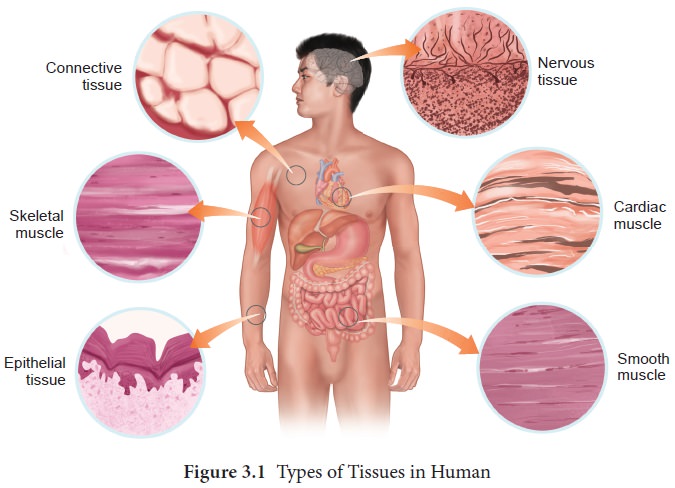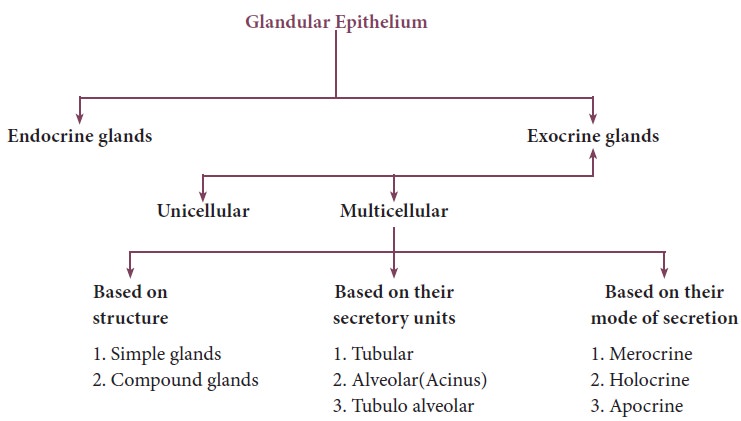Zoology - Epithelial Tissue | 11th Zoology : Chapter 3 : Tissue Level of Organisation
Chapter: 11th Zoology : Chapter 3 : Tissue Level of Organisation
Epithelial Tissue

Epithelial
Tissue
Epithelial
tissue is a sheet of cells that covers the body surface or lines the body
cavity. It occurs in the body as a covering, as a lining epithelium and as
glandular, epithelium. The functions of epithelium includes protection, absorption, filtration, excretion, secretion and sensory
reception. Based on the structural modification of the cells, the epithelial tissues are classified into simple
epithelium and compound epithelium or stratified epithelium.
Simple
epithelium is composed of a single layer of cells. They are found in the organs
of absorption, secretion and filtration. Simple epithelial tissue is further
classified into squamous epithelium, cuboidal epithelium, columnar epithelium,
ciliated epithelium and pseudostratified epithelium (Figure 3.2). The squamous
epithelium is made of a single thin layer of flattened cells with irregular
boundaries. They are found in the kidney glomeruli, air sacs of lungs, lining
of heart, blood vessels and lymphatic vessels and are involved in functions
like forming a diffusion boundary and filtration in sites where protection is
not important. The cuboidalepithelium ismade of a single layer of cube like
cells. This tissue is commonly found in the kidney tubules, ducts and secretory
portions of small glands

Its main functions are secretion and absorption. The
columnar epithelium is composed of single layer of tall cells with round to
oval nuclei at the base. It lines the digestive tract from the stomach to the
rectum. The two modifications of this lining are the presence of microvilli on the apical surface of the
absorptive cells and Goblet cell which secretes the protective lubricating
mucus. The functions of this epithelium include absorption, secretion of mucus,
enzymes and other substances. If the columnar cells bear cilia on their free
surfaces they are called ciliated epithelium. This ciliated type propels mucus
by ciliary actions and it lines the small bronchioles, fallopian tubes and
uterus. Nonciliated type lines most
of the digestive tract, gall bladder and secretory ducts of glands.
Pseudo-stratified epithelial cells
are columnar, but unequal in size. Although the epithelium is single layered
yet it appears to be multi-layered because the nuclei lie at different levels
in different cells. Hence, it is also called pseudostratified epithelium and
its functions are protection, secretion and absorption. Ciliated forms line the trachea and the upper respiratory tract. The non ciliated
forms, line the epididymis, large ducts of a glands and tracts of male urethra.
Some of the cuboidal or columnar cells get specialized
for secretion and are called glandular epithelium (Figure 3.3). They are mainly
of two types: unicellular, consisting of isolated glandular cells (goblet cells
of the alimentary canal), and multicellular, consisting of cluster of cells
(salivary gland). On the basis of the mode of pouring of their secretions,
glands are divided into two categories namely exocrine and endocrine glands.
Exocrine glands secrete mucus, saliva, earwax, oil, milk, digestive enzymes and
other cell products. These products are released


Their
secretions called hormones are secreted directly into the fluid bathing the
gland. The exocrine glands are classified as unicellular and multicelluar
glands. The multicelluar glands are further classified based on the structure
as simple and compound glands, based on their secretory units as tubular,
alveolar (Acinus) and tubulo alveolar.
Based on the mode of secretion exocrine glands are classified as merocrine, holocrine and apocrine.

Compound epithelium is made
of more than one layer (multi-layered) of cells and thus has a limited role in
secretion and absorption(Figure 3.4). The compound epithelia may be stratified
and transitional.

Their
main function is to provide protection against chemical and mechanical
stresses. They cover the dry surface of the skin, the moist surface of buccal
cavity, pharynx, inner lining of ducts of salivary glands and of pancreatic
ducts. There are four types of compound epithelium namely, stratified squamous
epithelium, cuboidal epithelium, columnar epithelium and transitional
epithelium. Stratified squamous epithelium is of two types called keratinized
type which forms the dry epidermis of the skin and the non keratinized type
forms the moist lining of the oesophagus, mouth, conjunctiva of the eyes and
vagina. Stratified cuboidal epithelium mostly found in the ducts of sweat
glands and mammary glands. Stratified columnar epithelium has limited
distribution in the body, found around the lumen of the pharynx, male urethra
and lining of some glandular ducts.
Transitional Epithelium is found
lining the ureters, urinary bladder and part of the urethra. This epithelium allows stretching and is protective in
function.
All cells
of the epithelium are held together with little intercellular material. In most
of the animal tissues, specialized junctions provide both structural and
functional links between its individual cells. Three types of cell junctions
are found in the epithelium and other tissues. These are called as tight,
adhering and gap junctions. Tight junctions help to stop substances from
leaking across a tissue. Adhering junctions perform cementing to keep
neighbouring cells together. Gap junctions facilitate the cells to communicate
with each other by connecting the cytoplasm of adjoining cells, for rapid
transfer of ions, small molecules andsometimes big molecules.
Related Topics